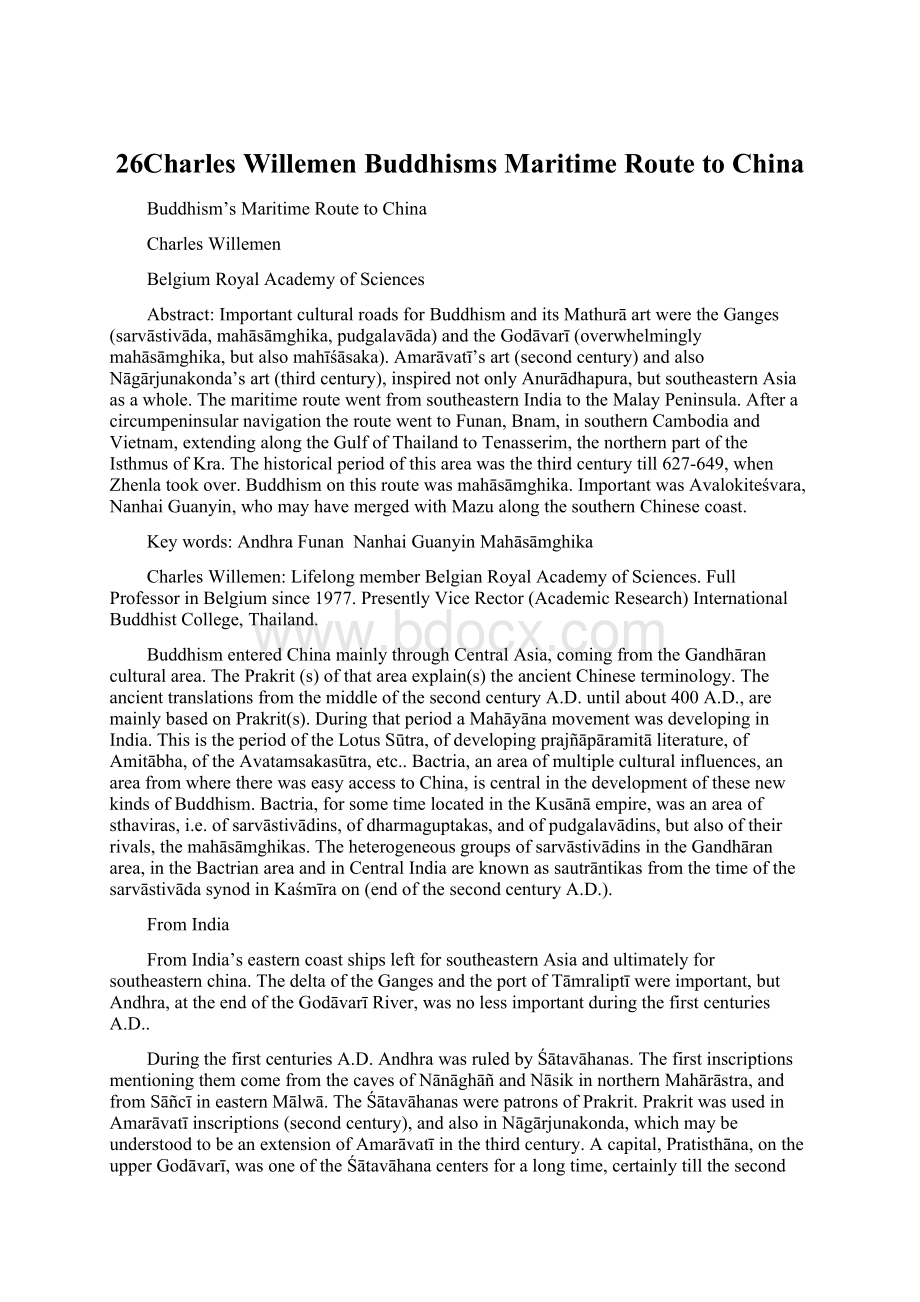26Charles Willemen Buddhisms Maritime Route to China.docx
《26Charles Willemen Buddhisms Maritime Route to China.docx》由会员分享,可在线阅读,更多相关《26Charles Willemen Buddhisms Maritime Route to China.docx(8页珍藏版)》请在冰豆网上搜索。

26CharlesWillemenBuddhismsMaritimeRoutetoChina
Buddhism’sMaritimeRoutetoChina
CharlesWillemen
BelgiumRoyalAcademyofSciences
Abstract:
ImportantculturalroadsforBuddhismanditsMathurāartweretheGanges(sarvāstivāda,mahāsāmghika,pudgalavāda)andtheGodāvarī(overwhelminglymahāsāmghika,butalsomahīśāsaka).Amarāvatī’sart(secondcentury)andalsoNāgārjunakonda’sart(thirdcentury),inspirednotonlyAnurādhapura,butsoutheasternAsiaasawhole.ThemaritimeroutewentfromsoutheasternIndiatotheMalayPeninsula.AfteracircumpeninsularnavigationtheroutewenttoFunan,Bnam,insouthernCambodiaandVietnam,extendingalongtheGulfofThailandtoTenasserim,thenorthernpartoftheIsthmusofKra.Thehistoricalperiodofthisareawasthethirdcenturytill627-649,whenZhenlatookover.Buddhismonthisroutewasmahāsāmghika.ImportantwasAvalokiteśvara,NanhaiGuanyin,whomayhavemergedwithMazualongthesouthernChinesecoast.
Keywords:
AndhraFunanNanhaiGuanyinMahāsāmghika
CharlesWillemen:
LifelongmemberBelgianRoyalAcademyofSciences.FullProfessorinBelgiumsince1977.PresentlyViceRector(AcademicResearch)InternationalBuddhistCollege,Thailand.
BuddhismenteredChinamainlythroughCentralAsia,comingfromtheGandhāranculturalarea.ThePrakrit(s)ofthatareaexplain(s)theancientChineseterminology.TheancienttranslationsfromthemiddleofthesecondcenturyA.D.untilabout400A.D.,aremainlybasedonPrakrit(s).DuringthatperiodaMahāyānamovementwasdevelopinginIndia.ThisistheperiodoftheLotusSūtra,ofdevelopingprajñāpāramitāliterature,ofAmitābha,oftheAvatamsakasūtra,etc..Bactria,anareaofmultipleculturalinfluences,anareafromwheretherewaseasyaccesstoChina,iscentralinthedevelopmentofthesenewkindsofBuddhism.Bactria,forsometimelocatedintheKusānāempire,wasanareaofsthaviras,i.e.ofsarvāstivādins,ofdharmaguptakas,andofpudgalavādins,butalsooftheirrivals,themahāsāmghikas.TheheterogeneousgroupsofsarvāstivādinsintheGandhāranarea,intheBactrianareaandinCentralIndiaareknownassautrāntikasfromthetimeofthesarvāstivādasynodinKaśmīraon(endofthesecondcenturyA.D.).
FromIndia
FromIndia’seasterncoastshipsleftforsoutheasternAsiaandultimatelyforsoutheasternchina.ThedeltaoftheGangesandtheportofTāmraliptīwereimportant,butAndhra,attheendoftheGodāvarīRiver,wasnolessimportantduringthefirstcenturiesA.D..
DuringthefirstcenturiesA.D.AndhrawasruledbyŚātavāhanas.ThefirstinscriptionsmentioningthemcomefromthecavesofNānāghāñandNāsikinnorthernMahārāstra,andfromSāñcīineasternMālwā.TheŚātavāhanaswerepatronsofPrakrit.PrakritwasusedinAmarāvatīinscriptions(secondcentury),andalsoinNāgārjunakonda,whichmaybeunderstoodtobeanextensionofAmarāvatīinthethirdcentury.Acapital,Pratisthāna,ontheupperGodāvarī,wasoneoftheŚātavāhanacentersforalongtime,certainlytillthesecondcenturyA.D.,thereignofVāsisthīputraPulumāvi(ca.130-159A.D.).ThemahācaityaofAmarāvatīwasprobablybuiltunderhisrule.In78A.D.,thefirstyearoftheŚākaera,anincursionledtothecreationoftwonewŚakakingdoms,i.e.thatofthewesternsatraps,Kùaharātas,destroyedin125A.D.,andthatofthegreatsatrapsofUjjayinī,Kārdamakas,whichdisappearedbetween388and409A.D.,conqueredbyCandraguptaII.InChinesetheŚakarulerswerecalledSaiWang,whichliterallymeansŚakaruler.InAndhratheIksvākuscontinuedtheŚātavāhanaruleinthethirdcentury,inNāgārjunakoõóa.Theyruledfromca.225tillca.325.ThegreatstūpaofNāgārjunakonda,theircapital,wascompletedca.246-256.
ThePallavasfollowedasrulersinsoutheasternIndia.Skandhavarman(earlyfourthcentury)wasthefirstgreatruler.ThecapitalwasKāñcīpura.TheyinitiallycontinuedPrakrittradition,buttheychangedtoSanskrit.ThePallavaswerethedominantpowerontheeasterncoastfromca.400toabout750A.D..FromtheestuaryoftheGodāvarītradersandscholarssetsailforsoutheasternAsiaandChina.TheŚākaera(of78A.D.),whichwasusedinthePallavaregion,wasintroducedtosoutheasternAsia.FromtheestuaryoftheKrsnāRivertradeandculturewereexchangedwithŚrīLańkā.
MahāsāmghikaswereonIndia’swesterncoast,buttheywerethedominantnikāya,school,inAndhra.ThereNāgārjunaorganisedamadhyamakagroupwithinthemahāsāmghikanikāya.HeusedSanskritinamainlyPrakritarea.MadhyamakareachedChinamainlyviaCentralAsiaandKumārajīva.ItwaspropagatedwithlimitedsuccessbyKumārajīva(344-413?
),whoarrivedinChang’anonFebruary8,403.Hiswork,basedonSanskrit,isthebeginningoftheoldtranslations,jiuyi.InAndhrathemahāsāmghikaswerebyfarthemainnikāyaforcenturies.Theyhadbodhisattvas,butbodhisattvaswhoalsoplayedaroleinsthāvirīyacirclesinnorthwesternIndia.Sautrāntikas,i.e.non-vaibhāsikasarvāstivādins,anddharmaguptakasalsohadbodhisattvas.DharmagptakaswerenotpresentonIndia’ssoutheasterncoast.SautrāntikaswerestronginCentralIndia,alongtheGangesuptoitsdelta.Ifmūlasarvāstivādins(endseventhcentury)reallyareacontinuationofsautrāntika-dārstantikas(endsecondcentury),onecanunderstandtheirpresenceinsoutheasternAsia,comingfromthedeltaoftheGanges,fromtoday’sBiharandBengal,Orissa.TheschoolsinAndhraweremahāsāmghika,knownascaitikaorśaila,butalsobahuśrutīya.CaitikasareoftenmentionedininscriptionsinAmarāvatī.Theirfinestshrineswereknownasmahācaityas.TherewasamahācaityainDhānyakañaka,identifiedwiththefamousstūpaatAmarāvatī(secondcentury).TherewasamahācaityaatNāgārjunakonda,etc..ŚailawasatermusedformahāsāmghikaslivinginthemountainsnearDhānyakañaka.Thetermmahāvanaśailaisusedtoo.Inscriptionsdistinguishpūrvaśailas(ontheeasternmountain)ofDhānyakañaka,andaparaśailas(onthewesternmountain).ThelatteroneswereknowninNāgārjunakondaasaparamahāvinaseliya.Thegreatstūpatherewasdedicatedtothem.Śailaswereonthewesterncoast,inKānheri.AllthismakesitclearthatAndhrawasinclosecontactwiththewesterncoast.CulturetravelledalongtheGodāvarīRivertoo,notonlyalongtheGanges.InNāgārjunakondathereweremahīśāsakastoo.Mahīśāsakaswereknownfortheirmeditationalpractices,dhyāna,acharacteristicofallnorthwesternschools.ThemahīśāsakasinAndhrahadcontinuouscontactwithŚrīLańkā(abhayagiri?
).
ŚrīLańkāntheravādins(mahāvihāra)wereinNāgārjunakonda.TheartofAmarāvatīandofNāgārjunakondaisalsofoundAnurādhapura.FromthesecondcenturyMathurā’sartwassendingdownimagestothegangeticplains,buttheGodāvarīcarriedtheartofMathurātoAndhra.FromtheretradeandculturewenttoŚrīLańkā.
Aparaśailascertainlyknewimageworship.ThemajordonatrixforthegreatstūpaatNāgārjunakondawastheladyCāmtisiri,arelativeoftherulerCāütamūla.SheiscomparedtoqueenŚrīmālāofthefamousscripturaltextabouttathāgatagarbha,theShengman(Śrīmālā),Jing,T.XII353,TheLion’sRoarofQueenŚrīmālā.Thistext,clearlymahāyāna,waswritteninamahāsāmghikaenvironment.TheChinesetranslationwasmadein436inJiankang(Nanjing)byGunabhadra(394-468),nicknamesMahāyāna.HearrivedinGuangzhouin435viathemaritimeroute,duringtheLiuSong(420-479).GunabhadraalsotranslatedtheLańkāvatārasūtra,T.XVI670,in443.Thistextcombinestathāgatagarbhaandālayavijñāna,storehouse-consciousness,andwasbasicfortheearlychanschoolinChina.India’ssoutheasterncoastisveryimportantastheplaceoforiginofchanpractices,maybeultimatelyoriginatinginIndia’snorthwesternarea.WhileinAndhratherulersweretolerantŚaivites,theroyalladieswereBuddhists.Thishabitseemstohavecontinuedine.g.Funan.
ToFunan.
ThemaritimeroutefromIndia’seasterncoastledtoFunanduringtheperioduptotheSuidynasty,581A.D..Paramārtha(499-569)wenttoChinaviaFunan.ItisgenerallyacceptedthatFunanisaphoneticrenderingofBnam,OldKhmerfor“Mountain”.Chinesephoneticrenderingsveryoftenhavesomemeaningtoo.Thechoiceofthecharacterswasnotonlydecidedbyadministrativeusage.CertainlyfromthefifthcenturyonSanskritplayedaneverincreasingroleforFunan’selite,butbeforethattimethelanguageseemstohavebeenOldKhmer,thelocalvernacularlanguage.WhiletheplaceoforiginoftheimportedIndianculturewasusingPrakrit(s),therewasnoobjectiontotheuseofthelocallanguageinFunan.ItseemsthatinitiallyOldKhmerwasrenderedinasouthernChineselanguage(Cantonese?
).however,steadysanskritizationtookplace,nodoubtinfluencedbythesituationin(Pallava)Indiaitself.
Yijing(635-716),duringtheTangdynasty,givesthenewphoneticrenderingBanan,i.e.Bnam.HetookthemaritimeroutetoIndiain671andreturnedtoLuoyangin695,atimewhenFunanwasjustavaguememoryinChina.FunanisbelievedtohavebeeninsouthernCambodiaandVietnam,extendingalongtheGulfofThailandtotheMalayPeninsula,toDunxun,alsowrittenDianxun.TheFunanrulerFanManextendedFunan’sinfluencetothatarea,whichisbelievedtobeTenasserim,thenorthernpartoftheIsthmusofKra.Basedonarchaeology,theoracenterofFunanshouldbeplacedinUthong,westcentralThailand.Thebestknown,bestresearchedportcityofFunanwasOc-eo.BoththeMenamandtheMekongbasinsseemtohavebeenpartofFunan.OurpresentknowledgeratherseesthecapitalintheregionofAngkorBorei,insouthernCambodia.OnlyaslateastheTang(618-907)TemuismentionedasthecapitalofFunan.Wedonotknowwhatthesecharactersreallym